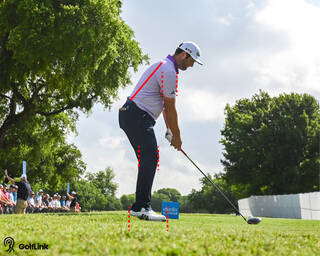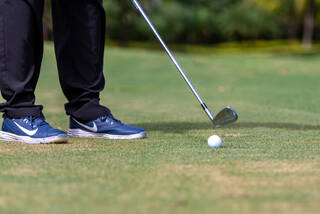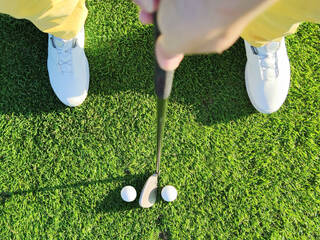Master The Proper Golf Swing: Step-By-Step Guide With Pictures
Learn how to hit a golf ball by mastering each of these simple steps to a proper golf swing

Golf captivates millions of people every year, and for many, once they get bit by the golf bug, they are addicted for life. Whether you're a novice or an experienced player, the quest for a proper golf swing is a common pursuit. With nearly 30 years of experience as a PGA Professional, my best advice to all golfers is simple: don’t forget to have fun.
Of course, when you learn how to hit a golf ball using a fundamentally sound golf swing, golf naturally becomes more fun.
While enjoyment is paramount, I recognize the perpetual desire among golfers to enhance their game and refine their swing. If you’re new to golf and still building your own swing, you’re probably looking for a strong foundation or a template from which to build from.
This article gives you a comprehensive, step-by-step guide on executing a proper golf swing. I firmly believe that knowledge empowers, and my aim today is to equip you with the insights necessary for elevating your golfing prowess.
This article will teach you the proper way to execute each of the following steps of the golf swing, so you can stop second-guessing your mechanics and start making noticeable improvements in your golf game:
- Posture
- Grip
- Alignment
- Ball Position
- The Backswing
- Transition
- The Downswing
- Impact
- Follow-Through
- The Finish
This essential guide is designed to benefit golfers of all levels. Any golfer can significantly enhance their game by devoting just a few minutes each day to mastering these fundamentals.
Pre-Swing Fundamentals
To start, let’s dive into what I call the Pre-Swing fundamentals. These elements are critical to learning and developing your game. The Pre-Swing fundamentals of Posture, Grip, Alignment, and Ball Position take place before swinging the club even starts, and can set you up for a successful shot before you even move the golf club.
The best players in the world always keep tabs on their Pre-Swing fundamentals, especially when things start to go a little sideways with their game.
Posture

In the address position you should bend forward from the waist, arms hang straight down, with knees bent slightly
Your posture is how you set your body up to the ball. Good posture is the foundation for creating a functional swing, which allows your body to move efficiently.
To be a good ball striker, you must be able to set your body up to fluidly perform all the necessary movements required to hit good shots.
Here are five easy-to-follow steps to getting into a good golf posture.
Step 1
Stand erect with a feeling as if the back of your head, your shoulders, middle back, lower back, and tailbone are all touching a wall. All along your spine, from the base of the back of your skull and down to your tailbone, envision a strip of velcro tape on it. That strip of velcro is stuck to the wall.
Step 2
Slowly peel that velcro tape off the wall, starting with your head.
Step 3
After you finish peeling the back of the head off the wall, you will follow your spine down and slowly peel the shoulders, mid back, and the start of your lower back off the wall.
Step 4
Do not peel your lower back, just above your hips, off the wall. By leaving that little bit on the wall, you get the upper part of your back more rounded. This will leave your hips over the center of your feet.
That last part is essential as many "old school" teachings often get golfers into a position with too much arch in the lower back. That creates tension and an inability to turn the body properly throughout the swing.
Step 5
Lastly, naturally, let your arms hang down from your shoulders as you take your grip on the club. You will ever-so-slightly flex your knees and feel your weight is in the balls or center of your feet.
Grip
Mastering the golf grip is crucial for a successful swing. Your hands are the only point of contact with the club, so a proper and comfortable grip is essential.

Master the Proper Golf Grip in 5 Easy Steps
Step 1
Begin with your lead hand, with the grip resting across the area where your fingers meet your palm. Then, close your fingers around the club, with your lead thumb running down the side of the shaft. Visualize the "V" formed by your thumb and forefinger pointing over your right shoulder as you address the ball.
Step 2
Next, place your trail hand on the grip under your lead hand and across the top of your fingers. The "V" formed by your thumb and forefinger should point over your trail shoulder at address.
Step 3
You have several options for connecting your hands, but it's important not to grip the club too tightly. Tension in your forearms and shoulders can hinder your swing.
Alignment
Alignment is one of the most crucial pre-swing fundamentals for setting yourself up for a successful swing.
Step 1
From behind the ball, make sure the ball and your intended target align. Visualize a line from behind the ball to your target.
Step 2
Identify an object on your target line closer to the ball to serve as your intermediate target, aiding in alignment.
Step 3
As you approach the ball, set your clubface in line with your intermediate target.
Step 4
Ensure that your feet are parallel left (for right-handed golfers) to your target line.
Step 5
Maintain a shoulder-width stance, adjusting for club length. Your posture is critical, so refer to the previous section for guidance.

Perfect Golf Alignment Every Time: Setup For Success
Ball Position
The proper ball position in golf is essential for a successful swing. Correct ball position in relation to your stance and the club you're using can significantly impact your shot's trajectory and distance.
With your driver, the rule of thumb is to position the ball off your lead heal. This will help you launch the ball at impact, which is important for hitting good shots with the driver.
For fairway woods, hybrids, and longer irons, position the ball slightly forward of center in your stance; for shorter clubs, place it closer to the center. This ensures the clubface makes solid contact with the ball at the optimal attack angle.
Mastering ball position leads to more consistent and accurate shots, making it a fundamental skill for any golfer looking to improve their game.

Golf Ball Position 101 (Plus Printable Chart!)
The Swing: Understanding the Golf Swing
In this tutorial, I’ll teach you how to hit a golf ball by breaking down the swing into the following sections:
- The Backswing
- Transition
- The Downswing
- Impact
- Post-Impact or Follow-Through
- The Finish
The average golf swing takes only 1 to 1.5 seconds to complete, which is too little time to think about all the steps.
During a round, it's best to have no more than two swing thoughts. Practice sessions with a PGA or LPGA Professional Coach are the time for working on your swing and its components.
The Backswing

At the top of your backswing your back should be turned about 45-degrees more than your hips and your hands should be slightly higher than your shoulders
The body's movement in the backswing is a rotational motion. The hips rotate, and the upper body turns as you move back. The hips and upper body rotate around a fixed point, your spine.
Achieving a separation of approximately 45 degrees between the lower and upper body during the backswing – for example, your back turns 90-degrees and your hips turn 45-degrees – is crucial to creating a powerful coil that stores potential energy for release in the downswing.
Additionally, you should shift your pressure into your trail foot as you rotate your body back in the swing. Your Center of Mass (COM) will mostly stay over the ball and in line with your spine as you rotate around it. However, you will be shifting pressure into your trail foot, with about 80% of your Center of Pressure (COP) going into that foot at the top of your backswing.
The arms, hands, and club should work together throughout the swing. As the body rotates around the spine and shifts pressure into your trail foot, your arms, hands, and club will move back on a plane. The arms, hands, and club move together initially. As the backswing begins, the clubface stays square to the target line, and the arms and hands follow suit.
In the initial takeaway, you want to think low, slow, and wide. Right before the halfway back position, right around hip height, use your wrists to hinge the club up slightly.
As the club hinges, the shaft works up toward your trail shoulder. At the top of the backswing, for a standard shot, your hands should be just above your shoulder, your lead wrist and back of that lead hand should be flat, and your clubface should be in line with the back of that lead hand.

The Ball Removal Drill for a Sweeping Takeaway
Transition
The transition in the golf swing happens in a split second, but a good transition is critical for good ball striking.
The transition is the change of direction in the swing from the backswing into the downswing. It's important to understand that the transition actually begins a fraction before your hands reach the top of the backswing.
The transition is the start of your pressure shift into the lead side. In this move, you are slightly falling into your lead foot with your pressure, not your weight or center mass. That should stay in line with your spine and over the ball.
This shift moves your pressure from your trail foot into your lead foot. After this pressure shift, your body will start to unwind, and your hands, arms, and club will move down towards the ball on a slightly shallower plane than it went back on.
The Downswing
Mastering the proper downswing sequence is crucial for achieving a perfect golf swing. After the initial pressure shift forward in the transition, the following steps make up the proper downswing sequence:
- First, initiate the unwinding of the hips.
- Second, allow the upper torso or shoulders to begin unwinding.
- Third, ensure that the hands and club move down slightly shallower than they did during the backswing, maintaining the wrist hinge created earlier.
Throughout this sequence, maintain the shift of pressure into your lead side. Keep your spine and center mass over the ball as you gracefully unwind, leading to a more powerful and precise golf swing.
Impact

Mastering the impact position is critical to having powerful and accurate results as you strike the ball. As you approach this crucial moment, keep these essential points in mind.
Clear Your Hips
Your hips need to be fully rotated and past the point of the ball at impact. This will ensure that your hands and club have room to fire through unobstructed.
Belt Buckle/Belly Button Past the Ball
Picture driving your belt buckle or belly button past the ball. This is a great visual to help keep the body moving with momentum during and past impact. Many golfers think of the ball as the final destination of the swing, which is not at all the case.
Trail Shoulder Towards the Ball
Driving your trail shoulder towards the golf ball is another excellent visual or positional tip to remember as you move into and through the impact position. Some players like to feel as though they are hitting the ball with their trail shoulder.
Hands Slightly Ahead of the Ball
Leading with your hands and the shaft as you move into impact will ensure that you will compress the ball, or, in other words, use the clubhead's loft more effectively as you strike the ball.
Flat Lead Wrist
The best ball strikers have their lead hand, or the logo on their glove, in line with the club shaft, at impact. There is no "cupping" or an increased angle between the back of their lead hand and their wrist. At impact, the back of the hand should be facing the target.
Some "bowing," or having their wrist slightly ahead of the back of their lead hand, is OK for some as they move into the all-important impact position.
Square the Clubface
If you execute the previous checkpoints, you will naturally return a square clubface at impact, which, combined with a neutral swing path, results in effortlessly straight golf shots.
Shift Your Weight to Your Lead Foot
At impact, most of your weight should be transferred to your lead foot. Many golfers struggle to execute this and leave a considerable amount of weight on the trail foot. This usually happens because they try to help the ball up with too much of an upward swing path as they move into impact. Failing to properly shift weight to your lead foot is a huge cause of poor and inconsistent ball striking. If you can execute this move, you’re on your way to quality ball striking.
Post Impact / Follow Through

The swing does not end once you've struck the ball
The swing is far from over once the ball has left the clubface. It's crucial to understand that impact is not the end of your swing. If you treat it as such, your swing will lack power and speed.
During post-impact and the follow-through, you must continue unwinding your body, unhinging the club, and moving your hands toward the finish. The club should be fully released, approximately 30 to 45 degrees post-impact, with your arms and club in a straight line.
Finish

Focusing on a perfectly balanced finish position from the start can set you up for a great swing
A successful finish position culminates a series of coordinated actions throughout your swing. In a good finish position, you should observe the following key checkpoints:
- All your weight and pressure should be on your lead side.
- Both your lower and upper body should be fully rotated.
- You should be in perfect balance.
I always advise my students to visualize achieving a good finish and being balanced before they swing. This mindset increases the likelihood of executing the preceding steps correctly. While it's not a guarantee, it certainly improves your chances.
Other Fundamentals: Speed and Tempo
Speed and tempo are two critical components in golf that significantly impact a player's performance. Speed denotes the velocity at which the clubhead moves through the impact zone, while tempo encompasses the overall rhythm and timing of the swing.
Integrating the right amount of speed into your swing is crucial for power and distance, but it's a delicate balance. Speed should never compromise accuracy.
Many golfers aim to increase their clubhead speed for longer shots, but it's equally important to maintain control and balance throughout the swing. Remember, it's not just about hitting hard; it's about swinging smart.
Conversely, tempo dictates the cadence and fluidity of the swing. Consistent tempo empowers golfers to retain authority over their shots, fostering improved timing and coordination. Discovering the right tempo is a highly individualized process, as each golfer possesses their unique natural rhythm and pace. Some players may thrive with a slower, more calculated tempo, while others may excel with a faster, more assertive tempo.
It is important to recognize that speed and tempo are intertwined aspects of the golf swing. Striking a harmonious balance between the two is pivotal for great ball striking.
A player with a swift swing tempo may benefit from maintaining a seamless transition and rhythm to avoid swinging too quickly. Conversely, a golfer with a slower tempo may need to concentrate on generating more clubhead speed without compromising control.
Improving your speed and tempo in the golf swing is a journey that often requires dedicated practice and expert guidance. Tools like video analysis and training aids can be invaluable in honing these aspects of your swing. By mastering your speed and tempo, you can achieve more consistent and powerful ball striking, leading to enhanced performance on the golf course.
Summing Things Up
Developing patience while learning the golf swing is essential. It takes a lot of time to make the techniques and timing required to hit a golf ball well second-nature.
Rushing the process can lead to frustration and bad habits. With patience, you can gradually improve and gain a deeper understanding of the mechanics involved in the proper golf swing, resulting in more consistent and effective performance on the course.
Getting coaching in golf can be incredibly beneficial for improving your game. A good coach can help you develop proper technique, provide valuable feedback, and offer personalized guidance to address your strengths and weaknesses. They can also help you avoid bad habits and provide support and encouragement as you progress.
Overall, investing in a coach can significantly accelerate your improvement and make the learning process more efficient and enjoyable.